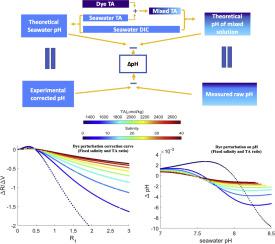Marine Chemistry ( IF 3.0 ) Pub Date : 2020-07-08 , DOI: 10.1016/j.marchem.2020.103849 Xinyu Li , Maribel I. García-Ibáñez , Brendan R. Carter , Baoshan Chen , Qian Li , Regina A. Easley , Wei-Jun Cai

|
Ocean acidification, a phenomenon of seawater pH decrease due to increasing atmospheric CO2, has a global effect on seawater chemistry, marine biology, and ecosystems. Ocean acidification is a gradual and global long-term process, the study of which demands high-quality pH data. The spectrophotometric technique is capable of generating accurate and precise pH measurements but requires adding an indicator dye that perturbs the sample original pH. While the perturbation is modest in well-buffered seawater, applications of the method in environments with lower buffer capacity such as riverine, estuarine, sea-ice meltwater and lacustrine environments are increasingly common, and uncertainties related to larger potential dye perturbations need further evaluation. In this paper, we assess the effect of purified meta-Cresol Purple (mCP) dye addition on the sample pH and how to correct for this dye perturbation. We conducted numerical simulations by incorporating mCP speciation into the MATLAB CO2SYS program to examine the changes in water sample pH caused by the dye addition and to reveal the dye perturbation mechanisms. Then, laboratory experiments were carried out to verify the simulation results. The simulations suggest that the dye perturbation on sample pH is a result of total alkalinity (TA) contributions from the indicator dye and chemical equilibrium shifts that are related to both the water sample properties (pH, TA, and salinity) and the indicator dye solution properties (pH and solvent matrix). The laboratory experiments supported the simulation results; the same dye solution can lead to different dye perturbations in water samples with different pH, TA, and salinity values. The modeled adjustments agreed well with the empirically determined adjustments for salinities >5, but it showed greater errors for lower salinities with disagreements as large as 0.005 pH units. Adjustments are minimized when the pH and salinity of the dye are matched to the sample. When the dye is used over a wide range of salinity, we suggest that it should be prepared in deionized water to minimize the dye perturbation effect on pH in the fresher sample waters with less well-constrained perturbation adjustments. We also suggest that the dye perturbation correction should be based on double dye addition experiments performed over a wide range of pH, TA, and salinity. Otherwise, multiple volume dye addition experiments are recommended for each sample to determine the dye perturbation adjustment. We further create a MATLAB function dyeperturbation.m that calculates the expected dye perturbation. This function can be used to validate empirically-derived adjustments or in lieu of empirical adjustments if dye addition experiments are unfeasible (e.g., for historical data). This study of dye perturbation evaluation and correction will improve the accuracy of the pH data, necessary for monitoring the long-term anthropogenic-driven changes in the seawater carbonate system.
中文翻译:

纯化的间甲酚紫染料扰动:它如何影响分光光度法pH测量
海洋酸化,由于大气中CO 2含量增加导致海水pH值降低的现象对海水化学,海洋生物学和生态系统具有全球影响。海洋酸化是一个循序渐进的全球性长期过程,其研究需要高质量的pH数据。分光光度法能够产生准确而精确的pH值,但需要添加指示剂染料,以扰乱样品的原始pH值。尽管在缓冲良好的海水中扰动较小,但该方法在缓冲容量较低的环境(如河流,河口,海冰融化水和湖相环境)中的应用越来越普遍,与较大潜在染料扰动有关的不确定性需要进一步评估。在本文中,我们评估了纯化的间甲酚紫(mCP)染料添加对样品pH的影响以及如何校正这种染料干扰。我们通过将mCP形态合并到MATLAB CO2SYS程序中进行了数值模拟,以检查由染料添加引起的水样pH值变化,并揭示染料扰动机理。然后,进行了实验室实验以验证仿真结果。模拟表明,染料对样品pH的扰动是指示剂染料的总碱度(TA)贡献以及与水样品特性(pH,TA和盐度)和指示剂染料溶液相关的化学平衡位移的结果性质(pH和溶剂基质)。实验室实验支持了仿真结果。相同的染料溶液可以在具有不同pH,TA和盐度值的水样中导致不同的染料扰动。建模的调整值与根据经验确定的盐度> 5的调整值非常吻合,但对于盐度较低且差异高达0.005 pH单位的情况,它显示出较大的误差。当染料的pH值和盐度与样品匹配时,调整最小化。当染料在广泛的盐度范围内使用时,我们建议应在去离子水中制备染料,以减少对扰动调节的约束较少的较新鲜样品水中对pH的扰动。我们还建议对染料的扰动进行校正应基于在较大的pH,TA和盐度范围内进行的两次染料加成实验。否则,建议对每个样品进行多次体积的染料添加实验,以确定染料的微调。我们进一步创建一个MATLAB函数 但是对于较低的盐度显示出更大的误差,分歧高达0.005 pH单位。当染料的pH值和盐度与样品匹配时,调整最小化。当染料在广泛的盐度范围内使用时,我们建议应在去离子水中制备染料,以减少对扰动调节的约束较少的较新鲜样品水中对pH的扰动。我们还建议对染料的扰动进行校正应基于在较大的pH,TA和盐度范围内进行的两次染料加成实验。否则,建议对每个样品进行多次体积的染料添加实验,以确定染料的微调。我们进一步创建一个MATLAB函数 但是对于较低的盐度显示出更大的误差,分歧高达0.005 pH单位。当染料的pH值和盐度与样品匹配时,调整最小化。当染料在广泛的盐度范围内使用时,我们建议应在去离子水中制备染料,以减少对扰动调节的约束较少的较新鲜样品水中对pH的扰动。我们还建议对染料的扰动进行校正应基于在较大的pH,TA和盐度范围内进行的两次染料加成实验。否则,建议对每个样品进行多次体积的染料添加实验,以确定染料的微调。我们进一步创建一个MATLAB函数 当染料的pH值和盐度与样品匹配时,调整最小化。当染料在广泛的盐度范围内使用时,我们建议应在去离子水中制备染料,以减少对扰动调节的约束较少的较新鲜样品水中对pH的扰动。我们还建议对染料的扰动进行校正应基于在较大的pH,TA和盐度范围内进行的两次染料加成实验。否则,建议对每个样品进行多次体积的染料添加实验,以确定染料的微调。我们进一步创建一个MATLAB函数 当染料的pH值和盐度与样品匹配时,调整最小化。当染料在广泛的盐度范围内使用时,我们建议应在去离子水中制备染料,以最大程度地减少对染料的扰动对较新鲜样品水中pH的扰动,而对扰动的调整要少得多。我们还建议对染料的扰动进行校正应基于在较大的pH,TA和盐度范围内进行的两次染料加成实验。否则,建议对每个样品进行多次体积的染料添加实验,以确定染料的微调。我们进一步创建一个MATLAB函数 我们建议应在去离子水中进行制备,以尽量减少染料扰动对较新鲜样品水中pH的影响,而扰动调整的约束应较少。我们还建议对染料的扰动进行校正应基于在较大的pH,TA和盐度范围内进行的两次染料加成实验。否则,建议对每个样品进行多次体积的染料添加实验,以确定染料的微调。我们进一步创建一个MATLAB函数 我们建议应在去离子水中进行制备,以尽量减少染料扰动对较新鲜样品水中pH的影响,而扰动调整的约束应较少。我们还建议对染料的扰动进行校正应基于在较大的pH,TA和盐度范围内进行的两次染料加成实验。否则,建议对每个样品进行多次体积的染料添加实验,以确定染料的微调。我们进一步创建一个MATLAB函数 建议对每个样品进行多次体积的染料加成实验,以确定染料的微调。我们进一步创建一个MATLAB函数 建议对每个样品进行多次体积的染料加成实验,以确定染料的微调。我们进一步创建一个MATLAB函数dyeperturbation.m,用于计算预期的染料扰动。如果染料添加实验不可行(例如,用于历史数据),则此功能可用于验证根据经验得出的调整,或代替根据经验进行的调整。这项对染料扰动评估和校正的研究将提高pH数据的准确性,这是监测长期人为驱动的海水碳酸盐系统变化所必需的。











































 京公网安备 11010802027423号
京公网安备 11010802027423号